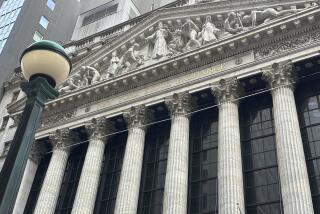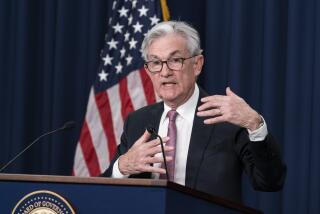Upward Pressure on Inflation Rate May Be Peaking
Bond yields posted one of their biggest one-day declines in years on Tuesday as new government data painted a picture of a U.S. economy where consumers arenât spending and inflation is muted.
The bond rally, and another surge in stock prices, indicated that the markets have shifted back to believing that the Federal Reserve Board will lower short-term interest rates soon--even though some Fed officials seemed to dash those hopes last week.
Perhaps more significant, some economists say the latest inflation reports suggest that the mild upward pressure on prices of goods and services over the past six months is peaking out.
That is important for the long-term health of bond and stock markets, because the threat of a sustained rebound in inflation--the scourge of the late â70s and early â80s--could easily destroy the bullish mood that has dominated Wall Street in this decade.
âInflation never picked up muchâ as the U.S. economy expanded briskly in 1993 and 1994, says Bruce Steinberg, economist at Merrill Lynch in New York. Now, he notes, the slowing economy should serve to contain inflationary pressures still in the pipeline.
The governmentâs report Tuesday that retail sales rose just 0.2% in May--far below expectations--offered more proof that the wind has been knocked out of the economy.
In a second report, the government said the consumer price index (CPI) rose 0.3% in May, down from Aprilâs 0.4% increase. And the âcoreâ consumer inflation rate--changes in prices of goods and services other than food and energy--inched up 0.2% in May, half Aprilâs rise.
Inflation is typically a lagging indicator, meaning it can take a long time to work through the system, from raw materials to finished goods to what consumers pay at the cash register. Although the economy has weakened this year, prices have been increasing at a faster pace than in 1994.
The CPI, which rose 2.7% in both 1993 and 1994, is up 3.6% annualized so far this year. The core CPI rate is running at a 3.1% annualized rate, up from 2.3% in the same period of 1994.
Some economists argue that the rise in inflation, while on the surface appearing minor, is disturbing. Not only does every increase in inflation erode consumersâ purchasing power, but the declining trend in inflation in much of the world makes rising U.S. prices appear more alarming.
âI think a 3.5% inflation rate today among developed countries is irresponsible,â says Robert Genetski, head of a Chicago economic consulting firm that bears his name. Moreover, he believes that the U.S. economy is stronger than it appears, and that a resurgence of growth later this year will be followed by a CPI rise of 4% to 4.5% in 1996.
If heâs right, he adds, the stunning decline in bond yields this year may be vastly overdone.
*
But many bond investors clearly are taking a much different view.
The steep plunge in longer-term interest rates on Tuesday--which pulled the yield on five-year Treasury notes down a remarkable 0.28 percentage point, from 6.15% to 5.87%--bespoke of a horde of investors still on the sidelines and eager to lock in yields on the assumption that the economy will stay weak and the Fed will cut short-term rates.
And overlaying those expectations, many analysts contend, is Wall Streetâs increasing faith that the longer-term outlook for inflation remains benign, despite temporary blips along the way.
Why be confident about inflation staying low? For starters, because high inflation is more the exception than the rule historically, economists say. While veteran investors today no doubt remember the horrendous inflation of the late â70s and early â80s--the CPI shot up 13.3% in 1979, for example--that was an anomaly, says Marc Miles, executive vice president at forecasting firm H.C. Wainwright Economics in Boston.
By 1982 the CPIâs rise was held to 3.8%. Since then, the biggest annual increase was 6.1% in 1990, as oil soared briefly after Iraq invaded Kuwait.
Yet last year, fear of surging inflation returned as the economy boomed and the Fed doubled short-term interest rates in response. Wall Street, in pushing long-term bond yields over 8% late last year, seemed to build in assumed annual inflation of 6% or higher. The bond buyerâs goal, of course, is to always earn a yield at least a couple points above inflation, to preserve purchasing power.
With long-term Treasury bond yields now nearing 6.5% again, itâs evident that investorsâ inflation assumptions have again been slashed. And thatâs quite logical, many economists say.
Prices of many commodities, which rose last year with the economyâs advance, have pulled back. Goldâs price, a classic early-warning indicator of inflation, has been flat for more than a year, Miles notes. And the growth of the nationâs money supply, the inflation harbinger watched by many Fed critics, has slowed markedly.
Perhaps most important, despite the economyâs expansion since 1992 and a tight labor market, wages arenât rising much. Average hourly earnings of non-executive workers are on track to rise 2.6% this year. That would be down from 2.7% last year.
In a global economy interwoven as never before--and incredibly competitive--the simple fact is that few workers can demand large wage gains. And without a surge in wage inflation, many economists argue that dramatic price inflation simply canât happen. Consumers wonât pay higher prices anymore because many of them canât.
The snailâs pace of wage hikes may not be a comforting thought for anyone who works for a living. But if that worker also happens to invest, a consolation is that low inflation and low interest rates are very comforting for financial markets.
* SLUGGISH ECONOMY
CPI, sales point to slowdown. D2
* YIELDS PLUNGE
Markets rally on economic data. D3
(BEGIN TEXT OF INFOBOX / INFOGRAPHIC)
No Raise, No Inflation?
Pay raises plunged in the mid-1980s and have remained low since--helping to dampen overall inflation. Annual increases in average hourly earnings of production and non-supervisory workers (private sector):
1995: +2.6%
Note: 1995 estimate is year-to-date change annualized.
Source: Labor Department
Consumer Prices
Percentage change, month to month, seasonally adjusted:
May 1995: 0.3%
Source: Bureau of Labor Statistics
More to Read
Inside the business of entertainment
The Wide Shot brings you news, analysis and insights on everything from streaming wars to production â and what it all means for the future.
You may occasionally receive promotional content from the Los Angeles Times.










